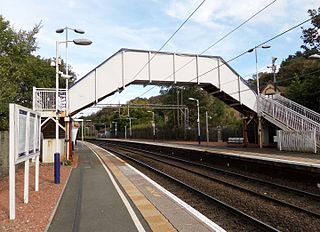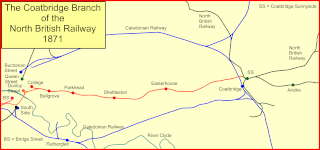
Bearsden is a town in East Dunbartonshire, Scotland, on the northwestern fringe of Greater Glasgow. Approximately 6 miles (10 km) from Glasgow City Centre, the town is effectively a suburb, and its housing development coincided with the 1863 introduction of a railway line. The town was named after Bearsden railway station, which was named after a nearby cottage.

The North Clyde Line is a suburban railway in West Central Scotland. The route is operated by ScotRail Trains. As a result of the incorporation of the Airdrie–Bathgate rail link and the Edinburgh–Bathgate line, this route has become the fourth rail link between Glasgow and Edinburgh.

The Bennie Railplane was a form of rail transport invented by George Bennie (1891–1957), which moved along an overhead rail by way of propellers.

The Maryhill Line is a suburban railway line linking central Glasgow and Anniesland via Maryhill in Scotland. It is part of the Strathclyde Partnership for Transport network. The line between Glasgow and Maryhill forms a part of the West Highland Line and was reopened to stopping passenger services in 1993. The line was reopened by British Rail and Strathclyde Passenger Transport Executive. Local services over the route had previously ended in the early 1960s, though it remained open thereafter for Fort William/Mallaig & Oban trains and freight traffic. In 2005 it was extended to Anniesland via a new station at Kelvindale in the north west of the city.

Kelvindale railway station is a railway station that serves the Kelvindale suburb of Glasgow, Scotland. It was opened on 26 September 2005 by Bill Butler, the then Member of Parliament in the Scottish Parliament and Councillor Alistair Watson. A bronze plaque records the event. The station is 5+1⁄2 miles (8.9 km) north of Glasgow Queen Street on the Maryhill Line.

Westerton railway station is a railway station that serves the Westerton district in the town of Bearsden, Scotland. The station is managed and served by ScotRail as part of the Strathclyde Partnership for Transport network. It is located on the Argyle and North Clyde lines, between Drumchapel to the west, Bearsden to the north, and Anniesland and Maryhill to the south-east. It is 6 miles 10 chains (9.9 km) west of Glasgow Queen Street, measured via Maryhill.
The Edinburgh–Bathgate line is a railway line in East Central Scotland. It is also known as the Bathgate branch and was originally operated by the Edinburgh and Bathgate Railway. Except for the short section at the original Bathgate terminus, the main line is still in use, with a frequent passenger train service operated by ScotRail.
The Glasgow, Yoker and Clydebank Railway was a railway company that opened in 1882, giving a rail connection to shipyards and other industry that developed in what became Clydebank. At first it was a purely local line, connecting only at Stobcross with the North British Railway, but as industry developed in the area it served it became increasingly important.
The Stobcross Railway was a railway line in Glasgow, Scotland, built by the North British Railway to connect from Maryhill to the new dock being built at Stobcross; the dock became the Queen's Dock, opened in 1877. The line was opened first, in 1874, and gave the North British company access to the north bank of the River Clyde; there was a goods depot at Partick.
The Whiteinch Railway was a railway line opened in 1874 in Scotland to connect industrial premises that had developed in the area with the Stobcross Railway, giving access to the main line network. It was opened for goods and mineral traffic, and was extended by the Whiteinch Tramway which fed directly into the factories and works.

Hillfoot railway station is a railway station in Bearsden, East Dunbartonshire near Glasgow, Scotland. The station is managed by ScotRail and is served by their trains on the Argyle and North Clyde Lines. It is sited between Milngavie and Bearsden, 7 miles 66 chains (12.6 km) from Glasgow Queen Street, measured via Maryhill.

Bearsden railway station serves Bearsden, East Dunbartonshire near Glasgow, Scotland. The railway station is managed by ScotRail and lies on the Argyle Line and North Clyde Lines. It is located between Westerton and Hillfoot on the line to Milngavie, and is 7 miles 21 chains (11.7 km) from Glasgow Queen Street, measured via Maryhill.
The Glasgow Central Railway was a railway line built in Glasgow, Scotland by the Caledonian Railway, running in tunnel east to west through the city centre. It was opened in stages from 1894 and opened up new journey opportunities for passengers and enabled the Caledonian Railway to access docks and industrial locations on the north bank of the River Clyde. An intensive and popular train service was operated, but the long tunnel sections with frequent steam trains were smoky and heartily disliked.
The Symington, Biggar and Broughton Railway was a railway company in southern Scotland. It built a line connecting Biggar, and later Peebles, to the main line railway at Symington. It was taken over by the Caledonian Railway in 1861, and was completed in 1864.
The Glasgow City and District Railway was a sub-surface railway line in Glasgow, Scotland, built to connect suburban routes east and west of the city, and to relieve congestion at the Queen Street terminus.
The Alloa Railway was intended to bridge the River Forth linking Alloa with the south without using a ferry.
The Caledonian and Dumbartonshire Junction Railway (C&DJR) was a Scottish railway opened in 1850 between Bowling and Balloch via Dumbarton. The company had intended to build to Glasgow but it could not raise the money.
The Glasgow, Dumbarton and Helensburgh Railway was independently sponsored to build along the north of the River Clyde. It opened in 1858, joining with an earlier local line serving Balloch. Both were taken over by the powerful North British Railway in 1865, and for some time the line was the main route in the area. As industry developed other lines were opened to serve it, and the line formed the core of a network in the area.

The Coatbridge Branch of the North British Railway was a railway built to connect the important coal and iron industrial districts of Coatbridge and Airdrie directly to Glasgow for the North British Railway.
The Kilsyth and Bonnybridge Railway was a railway line in central Scotland, built to exploit the mineral extractive industries in the area; it opened in 1888. A passenger service was run, but bus competition overwhelmed it after 1920 and the passenger service closed in 1935. The goods and mineral traffic continued, but it was dependent on the industries it served, and when they declined so did the business on the railway; it closed in 1964 and none of it is now in railway use.









